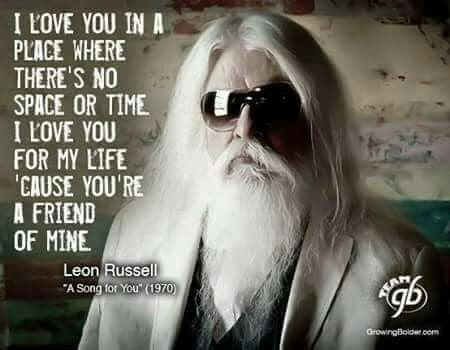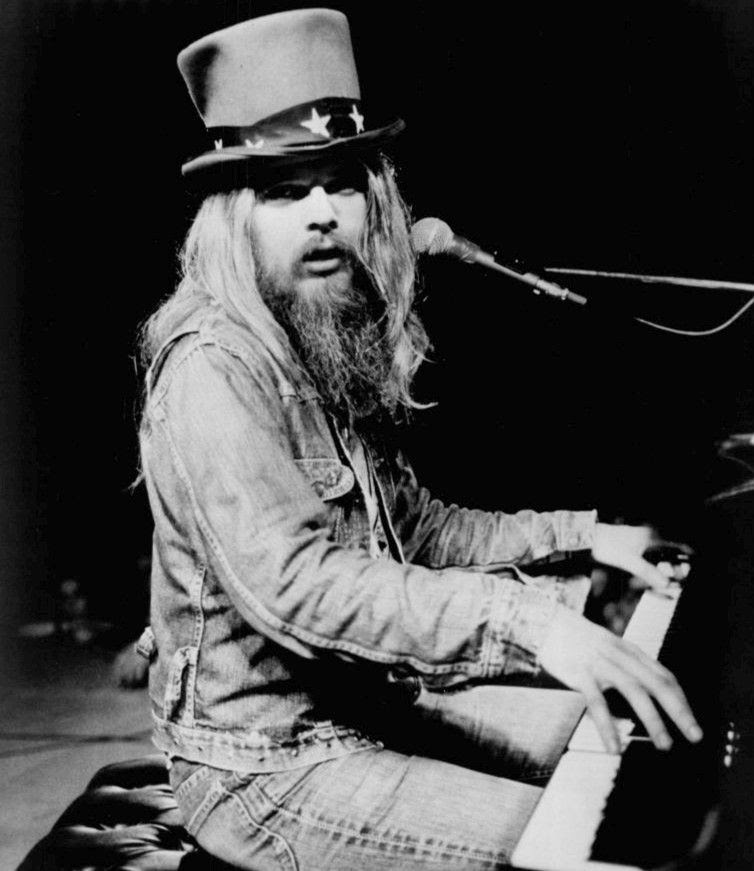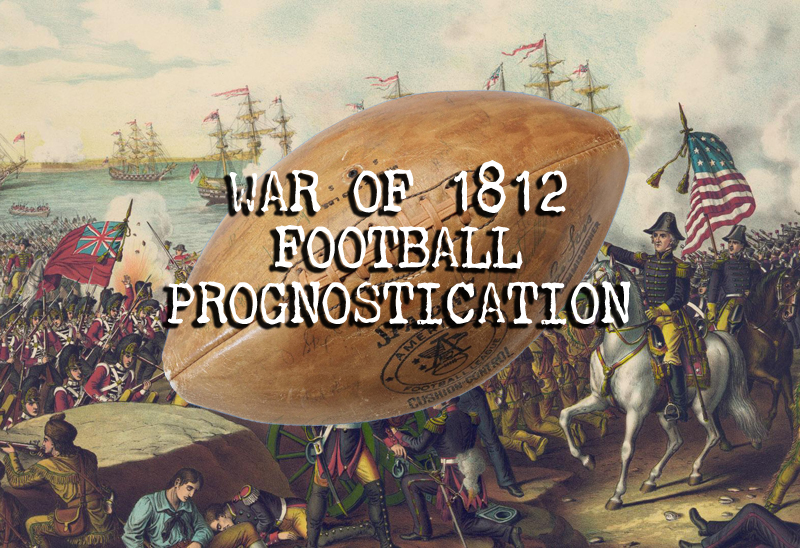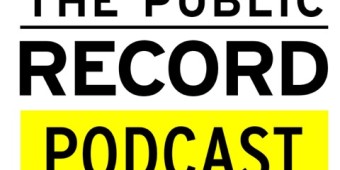
This week the world lost two more giants of the music world. First, Canadian poet, writer, singer & visionary Leonard Cohen left us at the age of 82. Then several days later, American singer-songwriter Leon Russell passed away at the age of 74. Both men were highly respected, multi talented and experienced careers that certainly had more than a healthy dose of ups and downs.
Today, we’ll focus on Claude Russell Bridges, whose stage name became Leon Russell. He was born in Tulsa, Oklahoma in 1942. He was part of a small musical genre that became known as the “Tulsa Sound.” This music could best be described as a gritty, bluesy, rockabilly, rock country, gospel hybrid of rock n’ roll. He went to the same high school, at the same time as the great blues legend Elvin Bishop and David Gates (Bread).
He was influenced & played with other Oklahoma based musicians like drummer Johnny Williams and the late, great J.J. Cale ( who Eric Clapton owes the successful launch of his solo career to after recording Cale’s “After Midnight” & “Cocaine” ). Russell first started his career playing piano and was known as a bit of a prodigy. At fourteen he was playing Tulsa nightclubs. The fake ID he needed to produce every night ( even though he was the entertainment ) had the name “Leon” written on it, so it stuck as his stage name.
In 1958 he moved to Los Angeles at the tender age of sixteen!!! He learned to play guitar, and found work quickly as a sideman, writer and touring musician. It is probably safe to say that he worked with everybody in the business, famous and not so famous. The credits list is incredible and goes into the hundreds. It just shows how much his talent was appreciated by other artists if not always by the public.Some of the names he worked with in the sixties include: The Beatles, The Rolling Stones, Frank Sinatra, B.B King, the Beach Boys, Doris Day, Eric Clapton, Willie Nelson, Barbra Streisand, Bob Dylan, Phil Spector, the Byrds, Glen Campbell and about another fifty more and that is just in his first decade. He had his first songs recorded by Joe Cocker and went on to produce & play on Cocker’s records, as well as organize Cocker’s very successful Mad Dogs and Englishmen tour.
This led to his first self titled solo album in 1970, featuring the track “A Song for You” on it. This song has now been recorded by more than fifty different artists. Artists as diverse as Willie Nelson, Ray Charles, Amy Winehouse and even ugh! ….. Christina Aguilera have done versions of the song.
Throughout the seventies he continued to write, produce, record & tour. He worked for even more and more big stars. He was in demand.
He even recorded several country albums and toured as “Hank Wilson” during the decade.
The 1980’s, were not as kind for artists like Leon. The MTV generation wanted visual artists and although he looked like the long lost fourth member of ZZ Top, his subtle, indirect style of writing and performing was overshadowed by the new video stars who were all a lot more about appearance than craftsmanship. He continued to record and perform, but like dozens of other singer-songwriters from the seventies, the rewards got smaller as the market shrunk.
By the late 1980’s, his career was in free fall. Although he still had work as a studio musician & guest-played on many other artists’ records, interest in his solo work was sparse. As a result he couldn’t tour very much due to lack of demand.
At this time, in the late eighties, we attempted to promote a tour of singer-song writer legends that included Russell with J.J. Cale and John Prine. The low Canadian dollar helped kill that from happening, but truth be told there seemed to be little interest on the part of promoters and fans. It likely would have been a loser for everybody financially, but I’m quite sure the performances would have still been outstanding.
Russell kept writing, recording, playing live and inspiring musicians right up to his death. Usually, it went unnoticed, but in 2010, Elton John decided to record with him and the result was “The Union Album,” the first charting non country album for Leon Russell since 1979. It was his sixth gold album. The record went to #3 in America and #7 in Canada. Elton John has always been a big fan and often cites Leon as his biggest influence and favourite piano player.
The record is okay, but hardly near the best of Leon’s long career.
We always have mixed feelings about such projects that also often produce mixed results. True, the forgotten legend gets some notoriety and deserves some success through a new audience discovering them and (hopefully) exploring their past work. On the other hand, the hyped work is often not their best and the whole process has a certain forced nature to it. Some examples:
1.) Roy Orbison. We remember Mr. Orbison, who had no record deal anywhere in the world in the late 1980’s, lamenting to us personally that there was zero interest in him from anybody at any record company on earth. Then along comes Canadian k.d. Lang, who was a hot, hyped artist at the time with big New York management and a sweet deal with Sire records. To her credit, she wanted to help Orbison, because he was a huge influence on her. So at her urging her management put an all star concert together that was filmed on September 30, 1987.
“Roy Orbison in Black & White” debuted on Cinemax the next year and was a big hit, the record, CD, VHS, laser disc & subsequent DVD, HD DVD & Blu-ray sales all went platinum. It included all sorts of guest appearances from the likes of Bruce Springsteen, Elvis Costello, Jackson Brown, Bonnie Raitt, Tom Waits and of course k.d. Lang. The success of the venture was instrumental in launching the collaborative “Traveling Wilburys” which brought Orbison even more fame playing with George Harrison, Tom Petty, Bob Dylan & Jeff Lynne.
So in this case, the new-old collaboration brought the legendary artist great success. After several sold out tours with the Wilburys, Roy even recorded a successful solo record that unfortunately he never saw succeed as it was released in early 1989 after his death toward the end of 1988.

We knew k.d. Lang when she was in her early days and toured promoting her hybrid brand of “Cow-punk” as her management labelled it. Kathy, with her butch crew-cut, dressed up in long square dance skirts & cowboy boots made quite the sight as she pranced around the stage like Minnie Pearl on Benzedrine. The whole stage show indeed sort of looked like what would happen if Federico Fellini made a film about Hee Haw.
We partied on more than one occasion with Kathy and her girlfriend and they seemed to be decent, genuine people in a business where both are in short supply.
The saddest sight however during those shows was virtuoso violinist Ben Mink wearing an ascot/kerchief around his throat and other obligatory western garb. He had recently left progressive band FM, who were a huge influence on Rush. He looked like the proverbial fish out of water, tolerating the charade like a Rhodes Scholar trying to show interest while working a phone line recruiting people for the University of Phoenix.
On the other hand, progressive rock seldom pays the bills, and Ben has been with Kathy Lang ever since. He is also her co-writer for much of her original material. Of course she went more or less mainstream shortly after her New Wave Western phase ended and become a huge star.
As much as we like her, k.d. Lang still tends to over-sing a lot of songs in our humble opinion. She is not alone. The tendency to blast, trill & vocally noodle every song into the stratosphere without subtlety is a style that Whitney Houston & Mariah Carey have also perfected. The Nigel Tufnell philosophy of always dial it up to “Eleven” just because it is bigger than “Ten” has been taken to heart by all three of those singers and many more.
As a result, we hate hearing her foghorn the vocal through her famous duet of “Crying” with Roy Orbison. The multi-octave voice of Mr. Orbison should never have to be corrupted by that type of competing dissonance, especially on his own legendary song. We recommend anybody who is interested to listen to Mr. Orbison’s original version and compare.
On the other hand, we can vividly recall Kathy giving stirring presentations of the Canadian National Anthem during the Winter Olympics one year and another time before a playoff hockey game in Alberta. They were some of the finest renditions of the song we have ever heard, partly because she showed appropriate vocal restraint.
2.) Johnny Cash. We have always loved the “Man in Black.” However his “American Recordings” album is one of the most overrated efforts of all time. The ailing legend was taken under the wing of super producer Rick Rubin in 1994 and he produced a record of Johnny doing a lot of odd, different types of songs that nobody would ever have expected him to sing. So points for originality.
Johnny is mostly narrating his way through the record as his voice is very, very weak. He kind of comes off as an Arkansas version of Leonard Cohen or Bob Dylan if they were narrating lyrics as they were falling under the effects of an anesthetic. It is only appropriate therefore that he sings a Cohen song on the record.
It is dramatic and haunting at times, but at the end of the day, …. mostly depressing and just generally, …. sort of pointless. The hype around it made it win lots of awards and sycophantic praise from critics who love these types of things and latch onto them like fleas on a shaggy dog. We don’t know anybody who still plays this record.
On the positive side, it sold well, created lots of interest in the country legend and secured him more recording projects right up to his unfortunate death in 2003.
3.) Carlos Santana. The mystical guitarist has always been a great musician, but commercial success has often evaded him. He has been playing since before Woodstock and has thrilled people with his guitar playing style and his thoughtful, expansive live shows. Unfortunately part of the reason he has suffered from an inconsistent career has always been that he does not write very much original material. He is also a very passive man.
His two best known songs “Black Magic Woman” and “Oye Como Va” were written by other people. Peter Green of the original English version of Fleetwood Mac & mambo legend Tito Puente respectively.
Enter legendary record company executive, super producer, A&R man and silver sage Clive Davis. In 1999 “Supernatural” was released under Davis’ magic touch. The record had a who’s who of guest stars, and was cross promoted across many different media, ….. a formula Davis had used to great success in the past with such artists as Barry Manilow, Whitney Houston & Rod Stewart.
It was a monstrous success. Santana’s career was revived like never before.
The reason for this was the huge success of the single “Smooth” that became a #1 hit around the world. The song was written by Rob Thomas of Matchbox Twenty who sings it on the record. It went to number one for 12 weeks, close to a record. Now Thomas and another collaborator are listed as the only writers. Santana gets no writing credit and didn’t insist upon it when he selected it for his album. However it is his soaring, ethereal guitar playing that makes the song.
Take that guitar out of the tune and this song is nothing. Now writing credits are often contentious animals. However, nobody would deny that the guitar playing in this song more than accounts for collaborative credit and deserves an equal portion of the writing royalties for the song. So unless Rob Thomas or his other writer can produce a demo tape where they show any semblance of the guitar melody and solo being present ( we seriously doubt it), we will choose to logically believe all of the guitar playing on this is original and a product of the talent & imagination of Mr. Santana.
Nobody in the music business believes that Rob Thomas wrote any of the guitar part of this. In the end, Clive Davis didn’t want any controversy and didn’t encourage Carlos to insist on taking credit. Of course none of them expected this song, “Smooth” to be even a single off the album, let alone the monster hit it became. The money involved here in royalties is in the high tens of millions.
Sure, everybody got really rich off this record anyway, but almost any other artist would never have let this slide. But Carlos Santana has always been an easy going, nice man. A fairly submissive beta guy in a business full of dominant alphas. In the record business that is pretty rare.
Leon Russell has never had a problem writing his own material. Everybody in the business, big and small, country through heavy metal has recorded Leon Russell penned songs. Here is one of our all time favourites. A song that laments the plight of Native Americans. An issue that Russell always took to heart after witnessing some of the grim conditions they lived under in his native Oklahoma.
“Here comes Uncle Sam with the same old bag of beans
Here’s the local Chief on the radio
He’s got hungry mouths to feed
…… back home in Alcatraz.”
This version by Scottish hard rockers’ Nazareth in 1973 holds up pretty well and shows the extent of Leon Russell’s influence throughout the spectrum of styles in the musical world.
This is because he wrote that way deliberately. Leon Russell once said in an interview that he never tried to write a monster hit song, or was trying to come up with an irresistible riff or melodic repetition that would produce a financial windfall. In fact he said he didn’t like listening to most big hit songs because they were too simple and overproduced. He liked a little bit of raw energy and rough edges in his music and that always showed in his work.

He said he would always rather produce good records every time, rather than an occasionally excellent record amidst many poor ones. that pretty well sums up his efforts. Leon made over 35 solo & band albums in his career and has written somewhere between 450-500 recorded songs.
Very few of his records are going to grab a listener at first listen and cause them to start endlessly playing them non stop. Many of his songs take many plays to appreciate. Play a Leon Russell album a half dozen times, and we’ll bet most people would develop a far greater appreciation of for its craft and quality than they ever would have suspected on first hearing.
Unfortunately we can’t say that about much other music today. Your first impression is usually proven correct upon subsequent listening.
Thursday, November 17, 2016
New Orleans @ CAROLINA (-4)
Two teams coming off tough losses that are also difficult to assess at first glance.
New Orleans had a go-ahead extra point blocked with minutes to go in the fourth quarter and saw the block returned for two points to lose 25-23 at home to Denver, ….. the first time that has ever happened in an NFL game.
Carolina committed two turnovers in the fourth quarter to blow a big lead and lose at home as well, falling 20-17 to the Chiefs. The arrogant Panthers behaved like children all afternoon, dancing and celebrating after all their previous scores as if they were going back to the Super Bowl. Of course, once again QB Cam Newton led the movement of staged sideline Saturnalia that seemed to piss off a lot of their own fans as well as the opposition who became motivated to turn the game around.
Once again, great leadership by the MVP who just hasn’t matured at all since the Panther’s Super Bowl loss last year to Denver.
The Saints come in to this game a lot more annoyed by their failure last Sunday than the Panthers seem to be if body language after their losses is to be believed. With Drew Brees playing well, spreading the ball around with great egalitarianism, the running game emerging and the defence playing more consistently, …… we’ll take the Saints to win an absolute must-win divisional game, or at least keeping it close enough to cover more than a field goal spread.
Brutal: Saints +4
Bob: Saints +4



